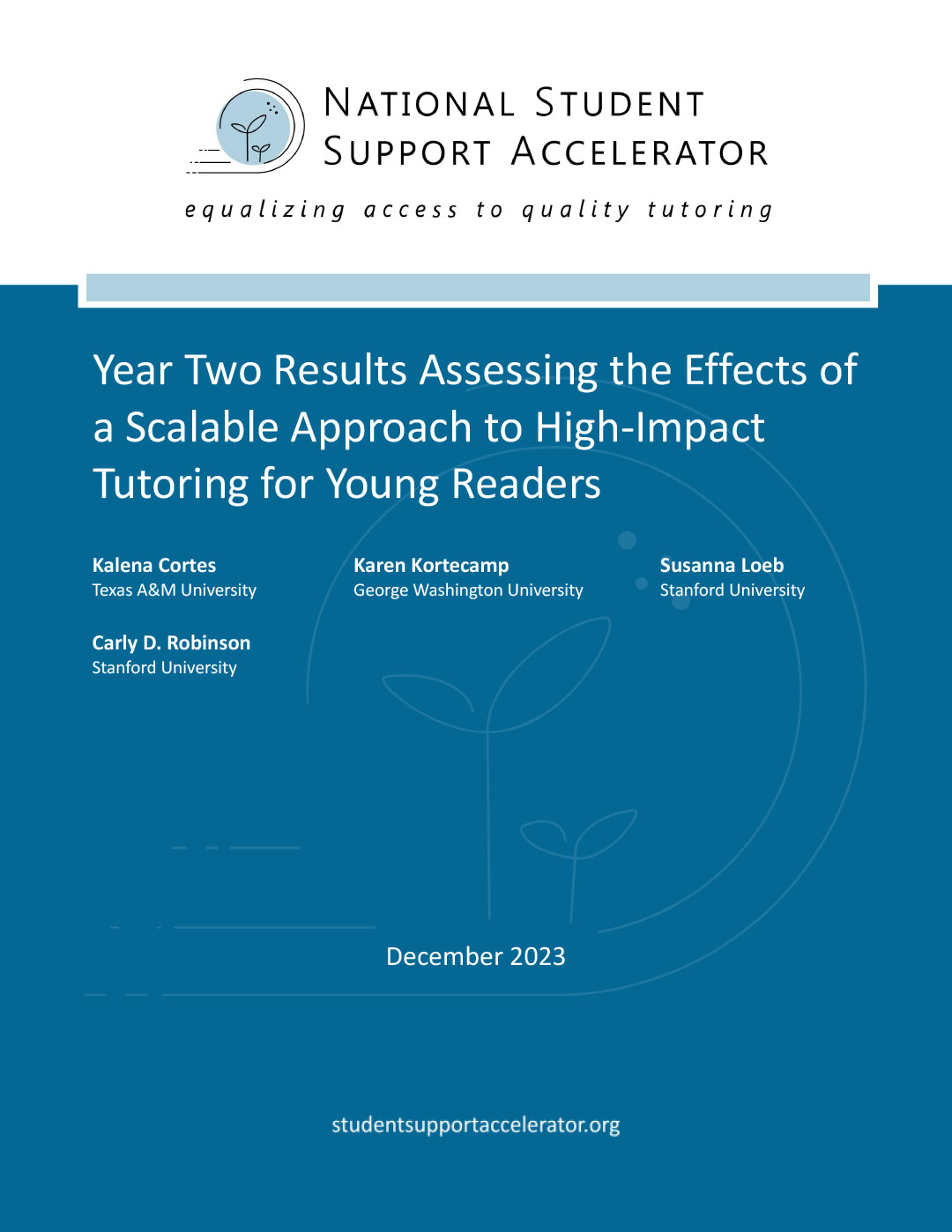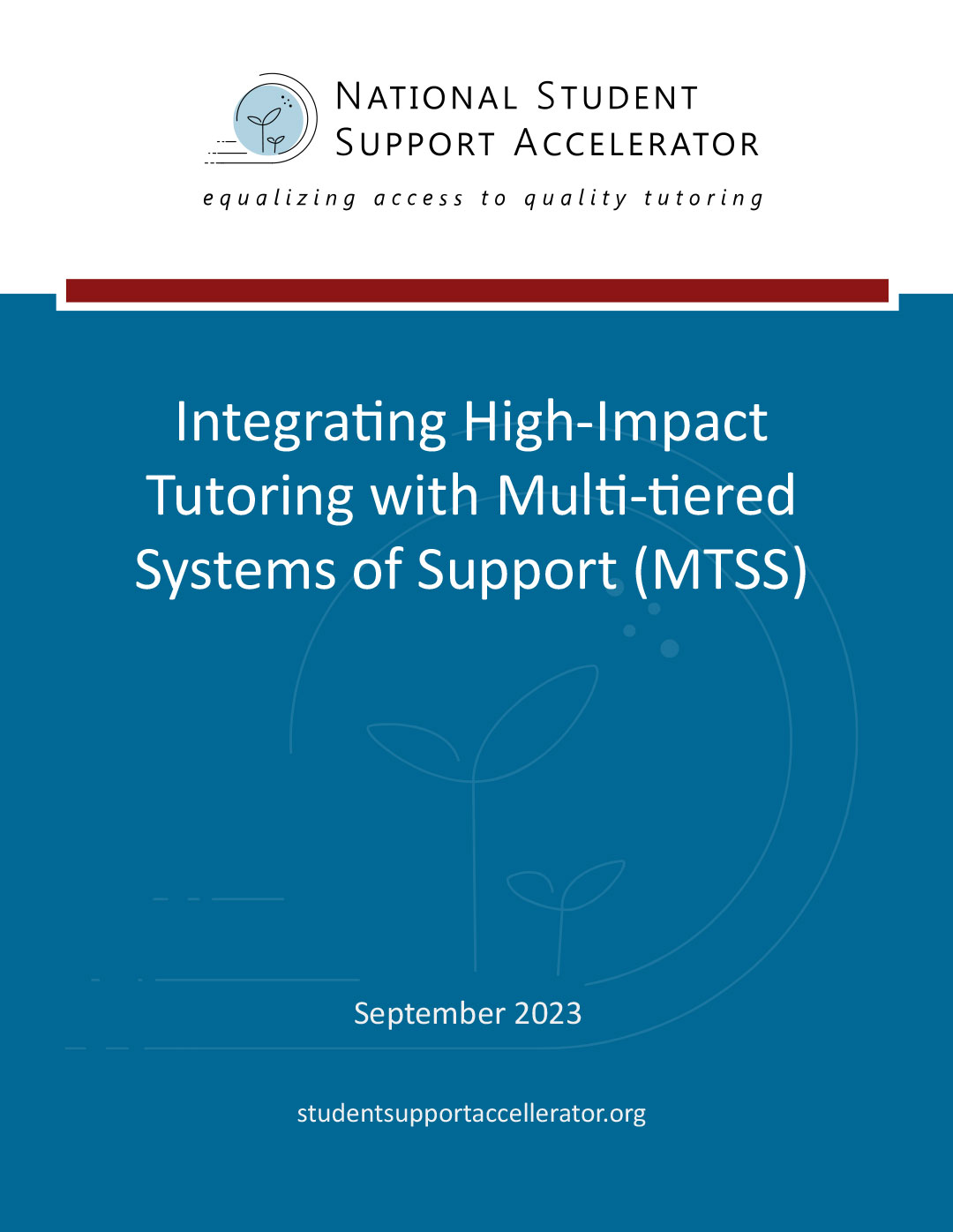Paraprofessionals as High-Impact Tutors: Opportunity and Guidance
High-impact tutoring is one of the most promising approaches for increasing student engagement and learning. Paraprofessionals already in schools can be excellent tutors during the school day if well supported with instructional materials and dedicated time for tutoring. This approach effectively addresses student academic gaps early,… more
Implementation of the OSSE High Impact Tutoring Initiative: First Year Report School Year 2022 – 2023
The District of Columbia (DC) Office of the State Superintendent of Education (OSSE) launched a three-year, $33 million investment in scaling and supporting high-impact tutoring (HIT) across DC, with a particular focus on students classified as “at-risk” or having experienced disrupted instruction during the COVID-19 pandemic. This… more
Design Principles for Accelerating Student Learning With High-Impact Tutoring
Research consistently shows that tutoring helps students learn, with numerous studies confirming its strong benefits. Driven by this evidence, policymakers and educational leaders nationwide are investing in tutoring initiatives. However “tutoring” can mean various types of educational support, and tutoring programs can differ… more
Effects of High-Impact Tutoring on Early Literacy Outcomes: A Pilot Study of a 1:1 Program With Existing Staff
During the 2022-23 school year, Try Once, Inc. (“Once”) partnered with a large, urban school district on the East Coast to provide high-impact early literacy tutoring to 105 kindergarten and first grade students in 13 schools. The district identified students as eligible for tutoring services if they scored below grade-level benchmarks… more
Outcomes-Based Contracting for Tutoring: Insights and Recommendations
Contracting relationships between public school districts and vendors are a common feature of education provision in the United States. Contracted services in schools can range from broad, essential functions such as school meals, bussing, and janitorial services to more specialized services such as the analysis of student data,… more
Learning Curve: Lessons from the Tutoring Revolution in Public Education
How often does it happen that a national policy priority, robust research, and the aspirations of classroom teachers converge? On an issue with bipartisan support, no less? Not very often. But tutoring is an exception. As many as 80 percent of school districts and charter school organizations have launched tutoring programs to help… more
Year Two Results Assessing the Effects of a Scalable Approach to High-Impact Tutoring for Young Readers
This research report presents the results from the second year of a randomized controlled trial of an early elementary reading tutoring program that has been designed to be affordable at scale. During the 2021-22 school year, over eight hundred kindergarten students in a large Southeastern school district were randomly assigned to receive… more
Funding for High-Impact Tutoring
This brief provides an overview of available funding for high-impact tutoring programs beyond Covid-19 relief funding (ESSER). Many streams of funding, on their own or braided together, can pay for high-impact tutoring in U.S. schools.
A Snapshot of State Tutoring Policies
As schools, districts, and states work to address the student needs following the pandemic, many turned to high-impact tutoring, a research-based approach to providing individualized instruction to students. In fact, thirty-seven percent of public schools reported providing “high-dosage” tutoring on a federal school pulse panel survey in… more
The Effects of Virtual Tutoring on Young Readers: Results from a Randomized Controlled Trial
This study is the first randomized controlled trial of a virtual early literacy tutoring program. OnYourMark Education provides tutoring grounded in the science of reading and focused on foundational literacy skills (e.g., phonics, phonological awareness, reading fluency). During the 2022-23 school year, OnYourMark partnered with 12… more
Integrating High-Impact Tutoring with Multi-tiered Systems of Support (MTSS)
Districts across the nation use Multi-Tiered Systems of Support (MTSS) to target appropriate supports for each student. High-impact tutoring is the most effective research-backed academic support – consistently demonstrating from six months to over two years of learning gains for students across grade levels and content areas in a single… more
Challenges and Solutions to Implementing Tutoring at Scale
Many districts sought to provide students with high-impact tutoring in response to pandemic-induced learning needs. Some started earlier than others, and we aimed to learn from the experiences of the early adopters to help inform a smoother implementation among those beginning the process later. During the 2021-22 school year, we… more
Research in Progress to Better Understand High-Impact Tutoring
This report lists ongoing and planned research studies related to high-impact tutoring, collected from researchers invited to the annual National Student Support Accelerator Conference in May 2023. Research studies are divided into three broad categories of work: Program effects, effects of program characteristics, and implementation.
A Scalable Approach to High-Impact Tutoring for Young Readers: Results of a Randomized Controlled Trial
In this brief, we present results from a randomized controlled trial of an early elementary reading tutoring program that has been designed to be affordable at scale. During the 2021-22 school year, over eight hundred kindergarten students in a large Southeastern school district were randomly assigned to receive supplementary tutoring… more
Do Teachers Support High-Impact Tutoring? A Survey Experiment
In the wake of the COVID-19 pandemic, tutoring has increasingly become a popular tool for learning recovery. By the end of the 2021-22 school year, 23 states (including the District of Columbia) initiated or passed legislation mandating or encouraging tutoring initiatives, and federal pandemic relief funds were made available for school… more
Early Lessons from Implementing High-Impact Tutoring at Scale
Many education leaders are turning to high-impact tutoring to accelerate student learning and compensate for interrupted instruction due to COVID-19. As federal, state, and local tutoring policies and practices develop, understanding the key barriers and challenges that have the potential to limit program reach and hinder efficacy and… more















